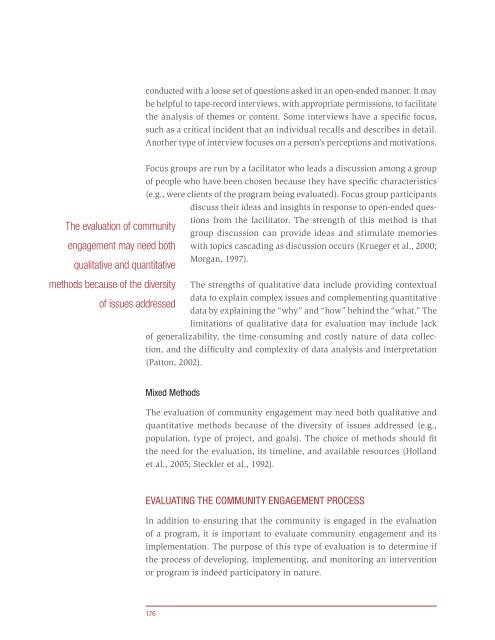Principles of Community Engagement (Second Edition)
Principles of Community Engagement (Second Edition)
Principles of Community Engagement (Second Edition)
Create successful ePaper yourself
Turn your PDF publications into a flip-book with our unique Google optimized e-Paper software.
The evaluation <strong>of</strong> community<br />
engagement may need both<br />
qualitative and quantitative<br />
methods because <strong>of</strong> the diversity<br />
<strong>of</strong> issues addressed<br />
conducted with a loose set <strong>of</strong> questions asked in an open-ended manner It may<br />
be helpful to tape-record interviews, with appropriate permissions, to facilitate<br />
the analysis <strong>of</strong> themes or content Some interviews have a specific focus,<br />
such as a critical incident that an individual recalls and describes in detail<br />
Another type <strong>of</strong> interview focuses on a person’s perceptions and motivations<br />
Focus groups are run by a facilitator who leads a discussion among a group<br />
<strong>of</strong> people who have been chosen because they have specific characteristics<br />
(e g , were clients <strong>of</strong> the program being evaluated) Focus group participants<br />
discuss their ideas and insights in response to open-ended questions<br />
from the facilitator The strength <strong>of</strong> this method is that<br />
group discussion can provide ideas and stimulate memories<br />
with topics cascading as discussion occurs (Krueger et al , 2000;<br />
Morgan, 1997)<br />
The strengths <strong>of</strong> qualitative data include providing contextual<br />
data to explain complex issues and complementing quantitative<br />
data by explaining the “why” and “how” behind the “what ” The<br />
limitations <strong>of</strong> qualitative data for evaluation may include lack<br />
<strong>of</strong> generalizability, the time-consuming and costly nature <strong>of</strong> data collection,<br />
and the difficulty and complexity <strong>of</strong> data analysis and interpretation<br />
(Patton, 2002)<br />
Mixed Methods<br />
The evaluation <strong>of</strong> community engagement may need both qualitative and<br />
quantitative methods because <strong>of</strong> the diversity <strong>of</strong> issues addressed (e g ,<br />
population, type <strong>of</strong> project, and goals) The choice <strong>of</strong> methods should fit<br />
the need for the evaluation, its timeline, and available resources (Holland<br />
et al , 2005; Steckler et al , 1992)<br />
EVALUATING THE COMMUNITY ENGAGEMENT PROCESS<br />
In addition to ensuring that the community is engaged in the evaluation<br />
<strong>of</strong> a program, it is important to evaluate community engagement and its<br />
implementation The purpose <strong>of</strong> this type <strong>of</strong> evaluation is to determine if<br />
the process <strong>of</strong> developing, implementing, and monitoring an intervention<br />
or program is indeed participatory in nature<br />
176

















